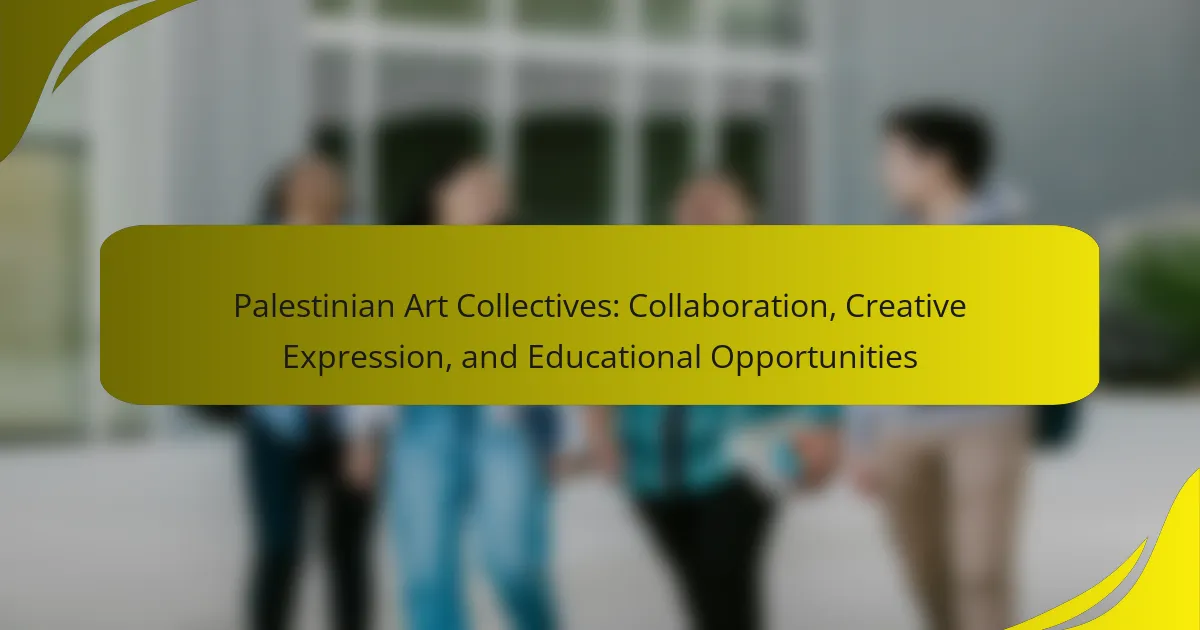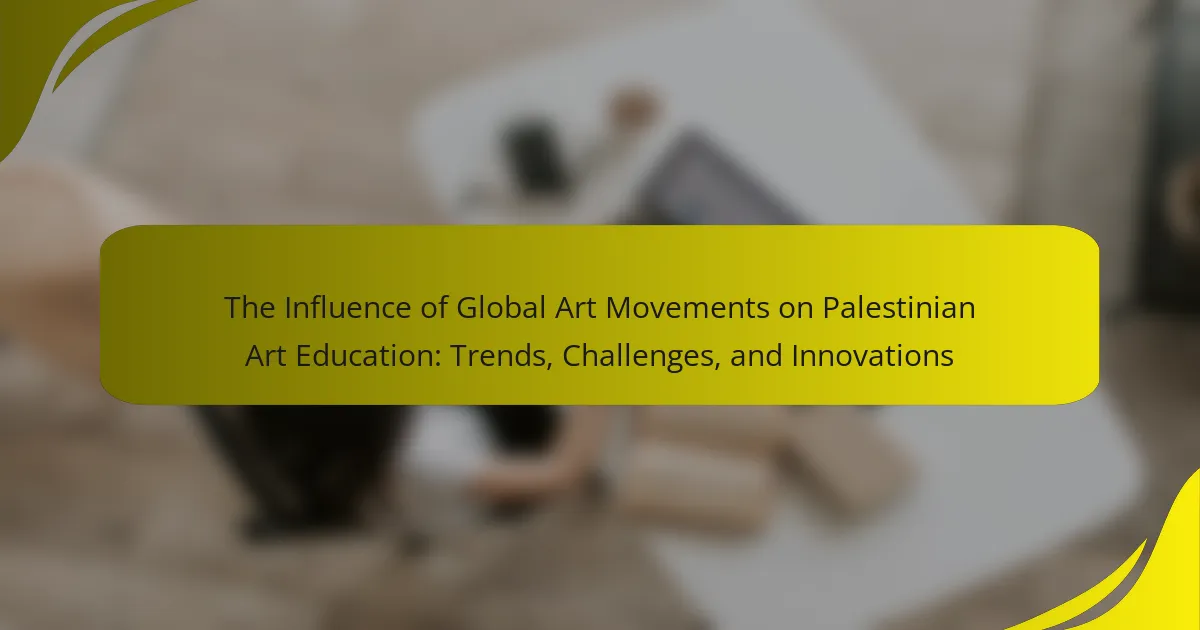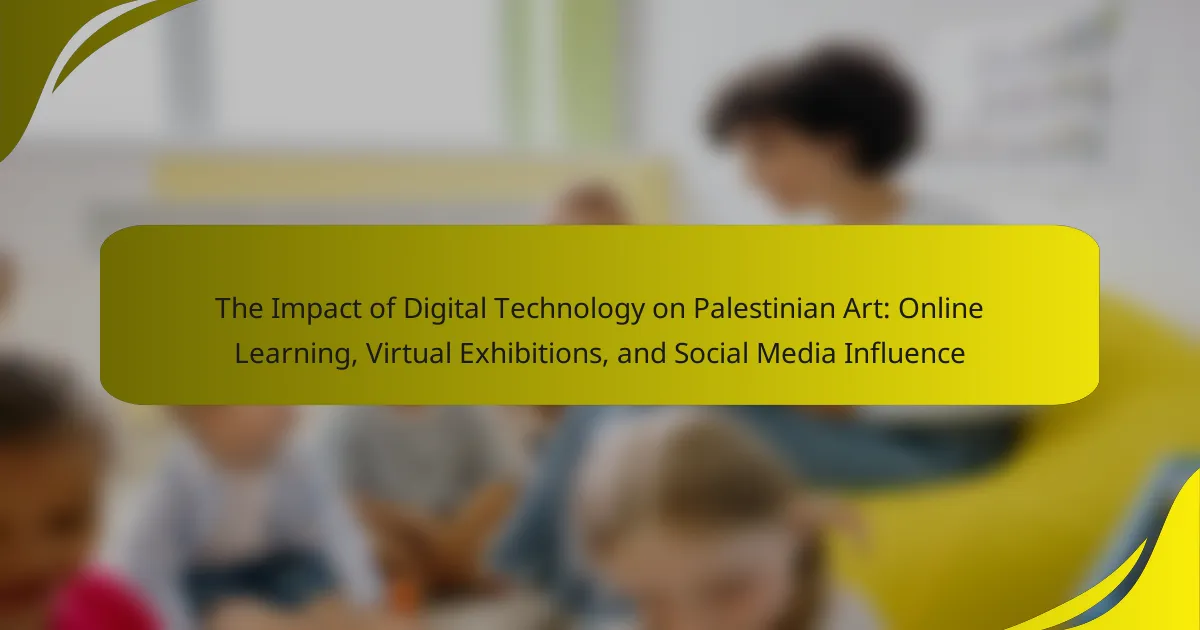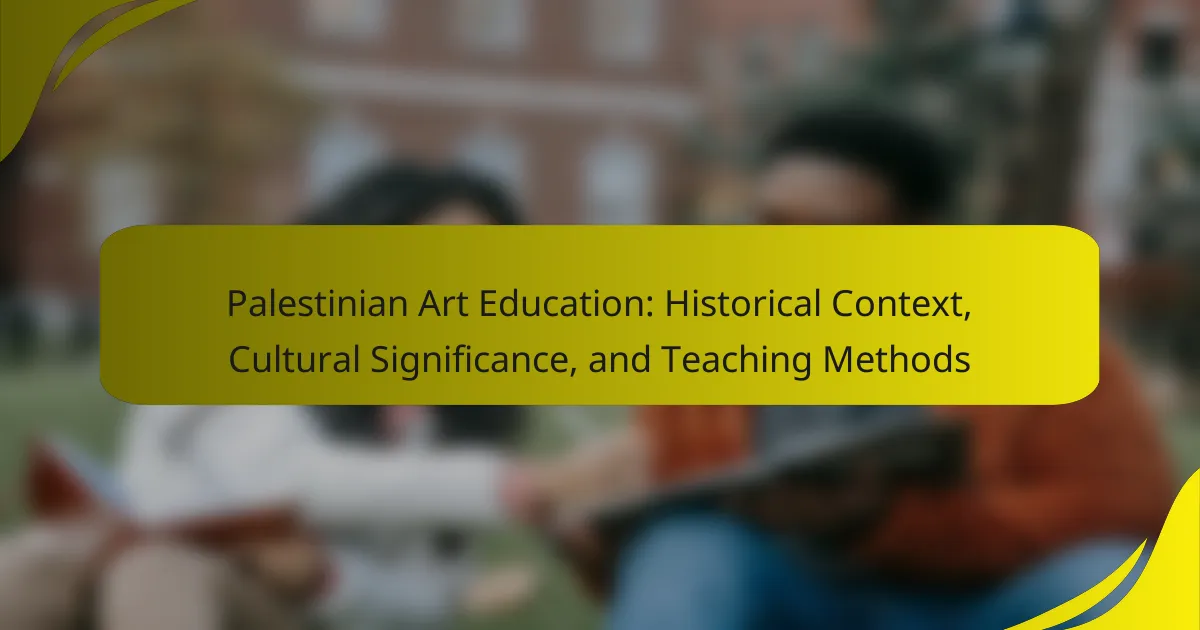Museums are vital entities in the landscape of Palestinian art education, serving as platforms for local artists and their works. They facilitate cultural heritage and artistic expression through exhibitions and outreach programs, which include workshops and lectures led by artists and educators. Additionally, museums provide educational resources for schools and universities, enhancing the understanding of Palestinian art history and contemporary practices. Despite facing challenges such as limited funding and political instability, museums continue to promote awareness and appreciation of Palestinian art through community engagement and collaborative initiatives.
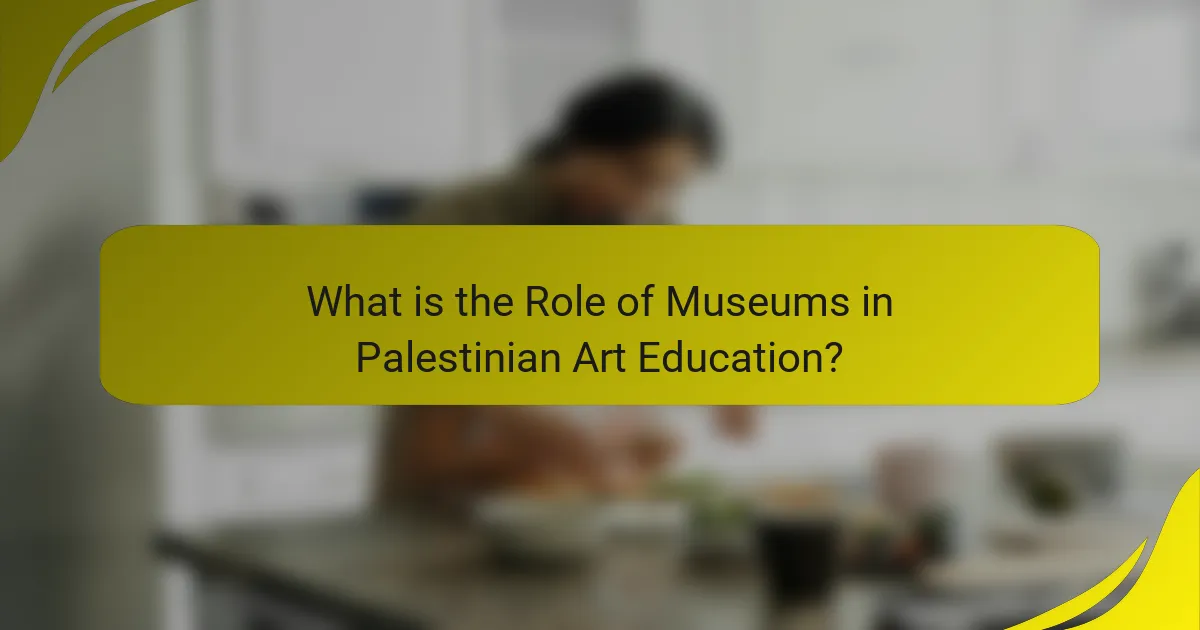
What is the Role of Museums in Palestinian Art Education?
Museums play a critical role in Palestinian art education. They serve as platforms for showcasing local artists and their work. Through exhibitions, museums promote cultural heritage and artistic expression. Museums also organize outreach programs to engage communities in art education. These programs often include workshops and lectures led by artists and educators. Additionally, museums provide educational resources for schools and universities. They create opportunities for students to learn about Palestinian art history and contemporary practices. By fostering dialogue and collaboration, museums enhance the understanding of art within the Palestinian context. This multifaceted approach supports the growth of artistic talent and appreciation in the region.
How do museums contribute to the understanding of Palestinian art?
Museums contribute to the understanding of Palestinian art by showcasing its history and cultural significance. They provide a platform for artists to display their work. Exhibitions often highlight themes of identity, resistance, and heritage. This exposure helps educate the public about Palestinian narratives. Museums also host workshops and lectures to deepen engagement. Educational resources, such as catalogs and guided tours, enhance learning experiences. Collaborative projects with local artists promote community involvement. These efforts collectively foster a greater appreciation of Palestinian art within a broader cultural context.
What are the key functions of museums in art education?
Museums play a vital role in art education by providing access to diverse artworks and cultural artifacts. They facilitate experiential learning through direct engagement with art. This interaction enhances critical thinking and creativity among students. Museums also offer educational programs tailored to various age groups. These programs include workshops, lectures, and guided tours. Additionally, museums serve as community hubs that promote cultural understanding. They often collaborate with schools to integrate art into the curriculum. Research shows that museum visits can significantly improve students’ appreciation of art and cultural heritage.
How do museums facilitate cultural exchange through art?
Museums facilitate cultural exchange through art by showcasing diverse artistic expressions from various cultures. They provide platforms for artists to share their work with a global audience. This exposure fosters dialogue and understanding among different cultural groups. Museums often host international exhibitions, highlighting artworks from different regions. These exhibitions promote appreciation for cultural diversity and artistic heritage. Additionally, museums engage in collaborative projects with foreign institutions. Such partnerships enhance cross-cultural learning experiences. Educational programs offered by museums also encourage discussions on cultural significance in art. Through these initiatives, museums create spaces for cultural interaction and exchange.
What impact do exhibitions have on Palestinian art education?
Exhibitions significantly enhance Palestinian art education by providing exposure to diverse artistic practices. They facilitate dialogue between artists and the community, fostering a deeper understanding of cultural narratives. Exhibitions also serve as platforms for emerging artists, showcasing their work and promoting their professional development. Educational programs accompanying exhibitions offer workshops and discussions that enrich the learning experience.
According to a report by the Palestinian Art Academy, over 70% of participants in exhibition-related workshops reported increased artistic skills. Furthermore, exhibitions contribute to the preservation of Palestinian heritage by highlighting traditional and contemporary art forms. By engaging with local and international audiences, exhibitions help to elevate Palestinian art on a global stage. This visibility encourages collaboration and support for local artists, ultimately strengthening the art education landscape in Palestine.
How do exhibitions showcase Palestinian artists and their work?
Exhibitions showcase Palestinian artists and their work by providing a platform for visibility and engagement. They display a diverse range of artistic expressions, including painting, sculpture, and multimedia installations. These exhibitions often highlight themes relevant to Palestinian identity and culture. They facilitate connections between artists and audiences, fostering dialogue about social and political issues. Many exhibitions are organized in collaboration with local and international art institutions. This collaboration helps to elevate the artists’ profiles on a global scale. Additionally, exhibitions may include educational programs that enhance understanding of the artists’ backgrounds and techniques. These initiatives contribute to the preservation and promotion of Palestinian art within the broader art community.
What themes are commonly explored in Palestinian art exhibitions?
Palestinian art exhibitions commonly explore themes of identity, resistance, and heritage. These themes reflect the cultural and historical context of Palestine. Artists often express personal and collective narratives through their work. Identity is portrayed through representations of Palestinian culture and traditions. Resistance is depicted as a response to political struggles and occupation. Heritage is celebrated by showcasing historical events and ancestral connections. Additionally, themes of displacement and longing are prevalent. Artworks frequently address the impact of conflict on communities. These themes resonate with audiences and foster understanding of the Palestinian experience.
How do outreach programs enhance art education in Palestinian communities?
Outreach programs enhance art education in Palestinian communities by providing access to artistic resources and experiences. These programs often include workshops, artist residencies, and community art projects. They facilitate engagement between local artists and students. Outreach initiatives help to bridge the gap between formal education and practical art experiences. They also promote cultural exchange and understanding through collaborative projects. Research shows that such programs improve creativity and critical thinking skills among participants. A study by the Palestinian Ministry of Culture highlights increased participation in art activities as a direct result of outreach efforts. This involvement fosters a sense of community and belonging, essential for cultural expression.
What types of outreach programs are implemented by museums?
Museums implement various types of outreach programs to engage with the community. Common programs include educational workshops, guided tours, and artist talks. These initiatives aim to enhance public understanding of art and culture. Many museums also offer community partnerships and collaborative projects. Such programs often target schools and local organizations. They aim to make art accessible to diverse audiences. Additionally, some museums create mobile exhibitions to reach underserved areas. These outreach efforts are essential for fostering appreciation of art within the community.
How do these programs engage local communities with art?
These programs engage local communities with art through interactive workshops and exhibitions. They provide hands-on experiences that encourage participation. Local artists often lead these workshops, fostering a sense of ownership. Community members can express their cultural narratives through art. Programs frequently include collaborative projects that unite diverse groups. They also host events that showcase local talent and creativity. According to a study by the Palestinian Museum, such initiatives enhance community cohesion and cultural pride. This evidence highlights the positive impact of art engagement on local communities.
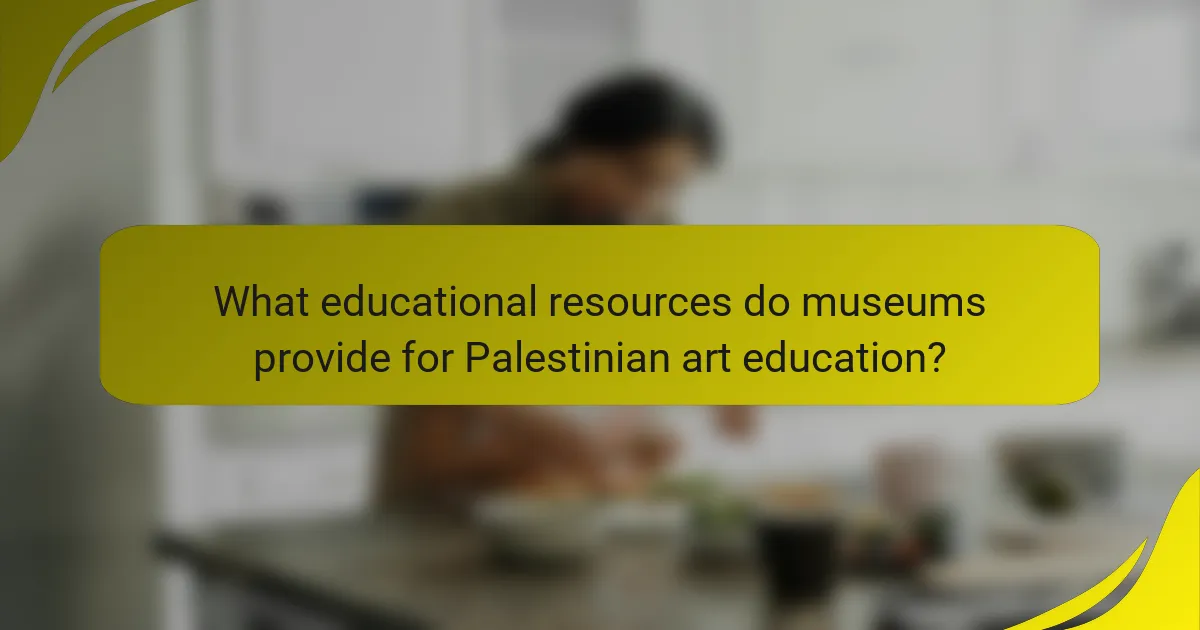
What educational resources do museums provide for Palestinian art education?
Museums provide various educational resources for Palestinian art education. These resources include workshops, lectures, and guided tours. Museums often organize art classes for different age groups. They also offer online resources, including digital exhibitions and educational materials. Collaborative programs with schools enhance art education. Museums may publish catalogs and articles on Palestinian artists. They often host community events to engage the public. These initiatives promote awareness and appreciation of Palestinian art.
How do museums develop educational materials for art educators?
Museums develop educational materials for art educators through a structured process. They assess the needs of educators and students to ensure relevance. Collaboration with art educators is vital for creating effective content. Museums often utilize their collections to inspire lesson plans and activities. They may conduct workshops to gather feedback on educational resources. Additionally, museums incorporate various media formats, including digital tools, to enhance engagement. Research indicates that interactive materials improve learning outcomes. This approach aligns with best practices in museum education, fostering a deeper understanding of art.
What types of resources are available for teaching Palestinian art?
Resources available for teaching Palestinian art include educational materials, workshops, and exhibitions. Museums often provide curated resources that highlight Palestinian artists and their works. Online platforms also offer digital archives and lesson plans related to Palestinian art. Community outreach programs facilitate hands-on experiences for students. Many art institutions collaborate with local artists to develop educational workshops. These workshops often focus on traditional techniques and contemporary practices in Palestinian art. Additionally, scholarly articles and books on Palestinian art serve as valuable references for educators.
How do museums support educators in integrating art into their curricula?
Museums support educators by providing resources and programs that enhance art integration in curricula. They offer workshops for teachers focused on art education methodologies. Museums also create educational materials tailored to specific age groups and subjects. These resources include lesson plans and activity guides. Additionally, museums host exhibitions that align with educational standards. They facilitate field trips, allowing students to experience art firsthand. Outreach programs extend museum resources to schools, fostering collaboration. By engaging educators, museums enrich the educational landscape and promote art appreciation.
How do museums collaborate with schools and universities in art education?
Museums collaborate with schools and universities in art education through various programs and initiatives. They offer guided tours that align with educational curricula. Workshops are conducted to engage students in hands-on art activities. Museums also provide access to their collections for research and study. Collaborative exhibitions are created that feature student artwork alongside professional pieces. Educational resources, such as lesson plans and online materials, are developed for teachers. Partnerships with local institutions enhance community engagement in art education. These collaborations foster a deeper understanding of art and culture among students.
What partnerships exist between museums and educational institutions?
Museums often partner with educational institutions to enhance learning experiences. These partnerships typically involve collaborative programs, workshops, and curriculum development. Museums provide resources such as artifacts and expert knowledge. Educational institutions benefit by integrating real-world contexts into their teaching. Joint initiatives may include field trips, internships, and research projects. For example, the Museum of Modern Art collaborates with schools for art education programs. Such partnerships foster community engagement and promote cultural awareness. They also enhance students’ critical thinking and creativity through hands-on experiences.
How do these collaborations enhance the learning experience for students?
Collaborations enhance the learning experience for students by providing access to diverse resources and expertise. Museums offer unique educational programs that complement classroom learning. These collaborations often involve hands-on activities, allowing students to engage with art directly. They also facilitate exposure to different cultures and perspectives, enriching students’ understanding. Research shows that students involved in museum programs demonstrate improved critical thinking skills. Additionally, partnerships with museums can lead to increased student motivation and interest in the arts. Overall, these collaborations create a more dynamic and interactive learning environment.
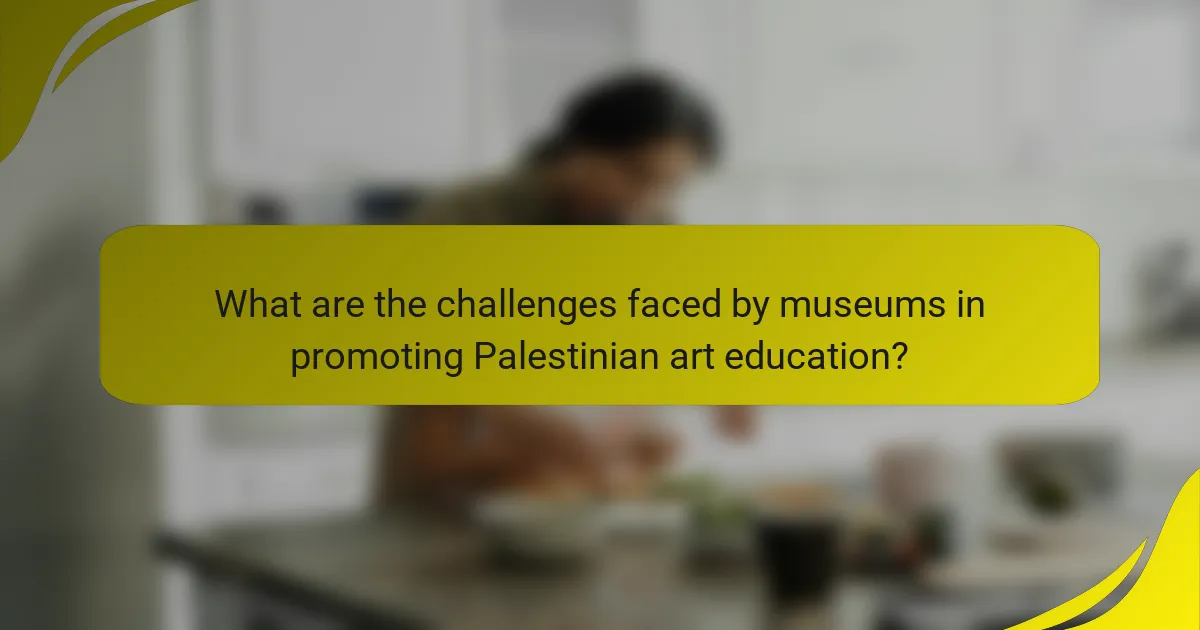
What are the challenges faced by museums in promoting Palestinian art education?
Museums face several challenges in promoting Palestinian art education. Limited funding restricts the development of comprehensive educational programs. Political instability often hinders collaboration with local artists and educators. Additionally, there is a lack of awareness about Palestinian art among broader audiences. This results in insufficient visitor engagement and participation in educational initiatives. Cultural sensitivity is crucial but can be challenging to navigate. Museums also struggle with resource allocation for exhibitions that accurately represent Palestinian narratives. Lastly, competition with other cultural institutions can dilute focus on Palestinian art.
What barriers exist in the accessibility of museum resources?
Barriers in the accessibility of museum resources include physical, financial, and educational obstacles. Physical barriers involve inadequate infrastructure for individuals with disabilities. Many museums lack ramps, elevators, or accessible restrooms. Financial barriers arise from high admission fees and transportation costs. Limited funding often affects outreach programs aimed at underserved communities. Educational barriers include a lack of awareness about museum offerings. Many potential visitors are unaware of available resources or how to access them. Cultural perceptions can also hinder engagement with museums. In some communities, museums may be viewed as irrelevant or elitist. These barriers collectively limit access to museum resources, particularly for marginalized groups.
How do political and social factors impact museum operations?
Political and social factors significantly impact museum operations. Political stability influences funding and support for museums. In regions with conflict, such as Palestine, museums may face resource limitations. Social factors, including community engagement and cultural relevance, affect visitor attendance. Museums must adapt their programs to reflect local social dynamics. For instance, political tensions can lead to changes in exhibited content. Museums may also serve as platforms for social dialogue, addressing community issues. The impact of these factors is evident in how museums curate exhibitions and develop outreach programs.
What strategies can museums employ to overcome these challenges?
Museums can employ several strategies to overcome challenges in Palestinian art education. First, they can enhance community engagement through outreach programs. These programs can include workshops and collaborative projects with local artists. Second, museums can develop educational resources tailored to diverse audiences. This includes creating bilingual materials that cater to both Arabic and English speakers. Third, leveraging technology can help museums reach wider audiences. Virtual exhibitions and online workshops can make art education accessible beyond geographical limitations. Fourth, forming partnerships with schools can integrate art education into curricula. This collaboration can foster a deeper appreciation of Palestinian art among students. Lastly, museums can actively seek funding and grants to support their initiatives. Financial resources can help sustain programs and expand their reach. These strategies are crucial for addressing the unique challenges faced by museums in promoting Palestinian art education.
What best practices can museums adopt to improve their role in art education?
Museums can adopt several best practices to enhance their role in art education. They should implement interactive exhibits that engage visitors actively. This approach fosters deeper understanding and appreciation of art. Collaborating with local schools for educational programs can extend their reach. Such partnerships can provide tailored art education resources for students. Offering workshops led by artists can also enrich learning experiences. These workshops can help participants develop practical skills in art-making. Additionally, museums should utilize digital platforms for virtual tours and online resources. This expands accessibility to art education beyond physical visits. Finally, soliciting feedback from the community can guide museums in refining their educational initiatives. Engaging the community ensures that programs meet the needs and interests of diverse audiences.
How can museums enhance community engagement in art education?
Museums can enhance community engagement in art education through interactive programs and exhibitions. They can offer workshops that involve local artists and educators. This collaboration fosters a sense of ownership among community members. Museums can also develop outreach programs that target schools and underrepresented groups. These initiatives can include guided tours and hands-on activities. Research shows that such engagement increases attendance and participation. For example, a study by the American Alliance of Museums found that interactive exhibits lead to higher visitor satisfaction. Additionally, museums can create online resources to reach a broader audience. This approach allows for continuous learning beyond physical visits.
What innovative approaches can museums take to promote Palestinian art?
Museums can adopt several innovative approaches to promote Palestinian art. They can host virtual exhibitions to reach a global audience. Interactive online platforms can allow users to engage with artists and their works. Collaborations with Palestinian artists can lead to unique, curated exhibitions. Workshops and artist talks can provide deeper insights into the cultural context of the art.
Educational programs in schools can incorporate Palestinian art to foster awareness. Community outreach initiatives can involve local artists and create inclusive spaces. Partnerships with international museums can facilitate cultural exchange and broaden visibility. Utilizing social media campaigns can effectively showcase Palestinian art and artists.
The main entity of this article is museums and their role in Palestinian art education. The article provides a comprehensive overview of how museums function as platforms for showcasing Palestinian artists, promoting cultural heritage through exhibitions, and engaging communities through outreach programs. It discusses the educational resources available for schools and universities, the impact of exhibitions on understanding Palestinian art, and the challenges faced by museums in promoting art education. Additionally, it highlights strategies and best practices that museums can adopt to enhance their educational initiatives and community engagement.
